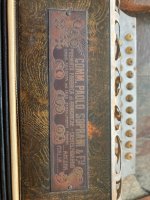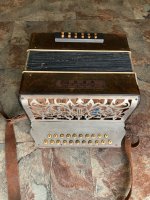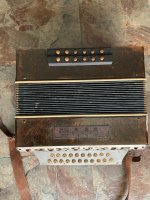The famous Paolo Sopranis are the "little grey Paolo" boxes built in the mid 20th century. I don't know what makes them so special, but this definitely isn't one of those. Yours is a lot older, for a start - maybe dating as far back as the early 1900s, but probably from the 10s or 20s.
As for the key, I'm not sure how much you know about button accordions/melodeons, but there are two main tuning systems.
Instruments intended for Irish music have the two rows tuned one semitone apart. The most common tuning is B/C, meaning the outer row plays in the key of B major and the inside row plays in C major. Obviously most Irish music is in the key of D, G or A, so the idea is that the entire box is more or less chromatic, and you can play any scale by playing "across the rows" - borrowing buttons from both rows. This works with any other semitone tuning, and other keys include C/C#, C#/D etc..
The other system has the rows tuned a fourth apart, e.g. A/D, G/C, Bb/Eb. Everywhere that has a melodeon tradition has a dominant tuning - D/G is popular for English dance tunes, G/C for French balfolk and C/F for German polkas etc.. With these instruments you tend to play in the two keys that the instrument is intended to play in, by playing "along the rows". Sometimes notes are borrowed from the other row to make playing more smooth, but otherwise most of the tune is played on one singular row.
As for determining the key, most diatonic button accordions or melodeons are set up with a "third button start" which means that the scale starts on the third button along on each row. If you press that button while squeezing the bellows inwards, that is probably the key of that row. This method isn't 100% safe though. If I were you I'd press several buttons together roughly in the middle of the row and squeeze inward, which would give you a major chord in the key of that row. You'll need a tuner, or an instrument that you can be sure is in tune, like a digital piano.
In fact, on that note, standard pitch has changed a number of times over the years, so while your box might be in tune with itself, there's no guarantee that it'll be in tune with other instruments!
Anyway, good luck getting it singing again, and keep us updated! If you need any more advice feel free to ask here, but I'd also recommend
www.melodeon.net, which is solely dedicated to diatonic accordions like yours : )



